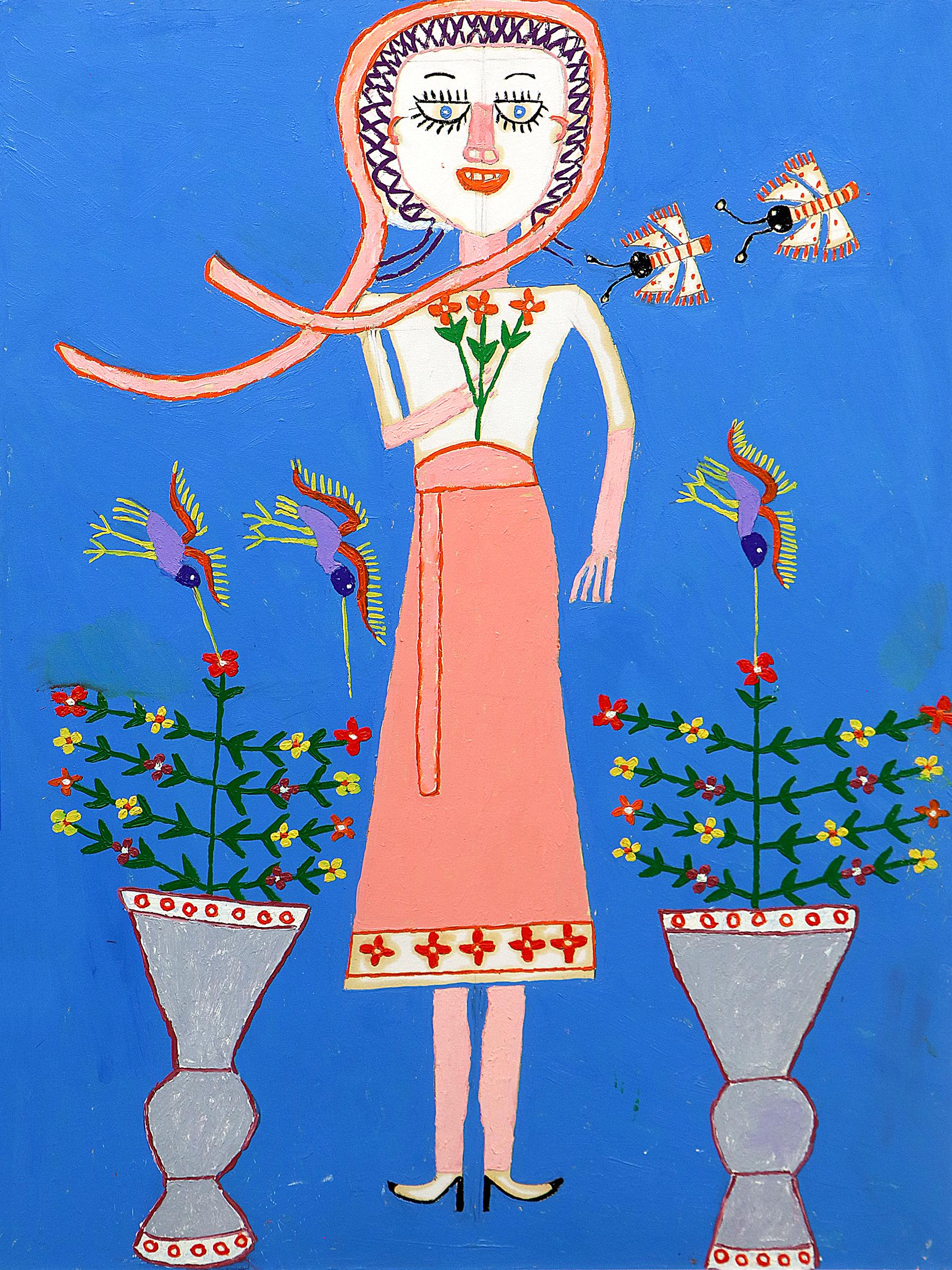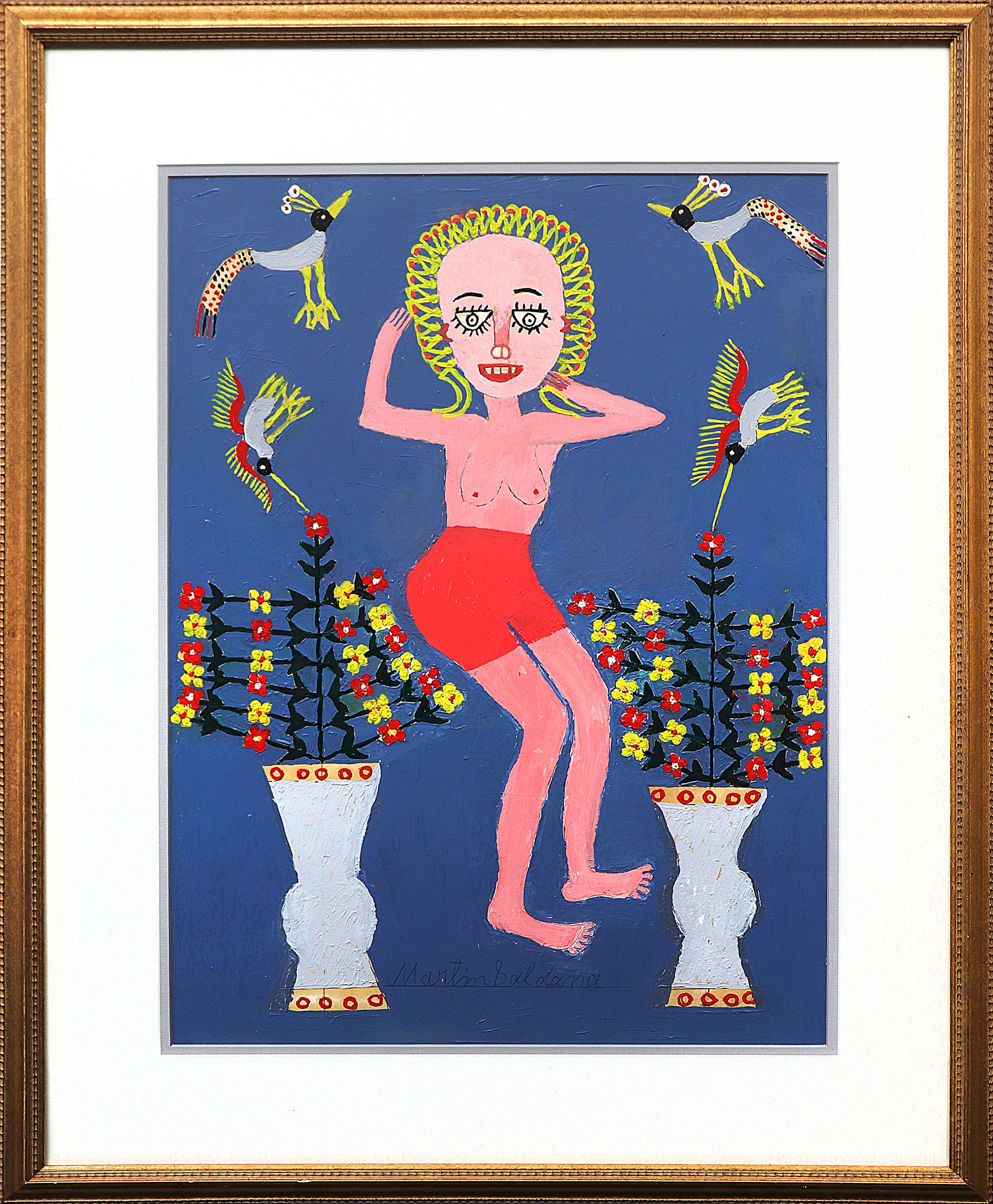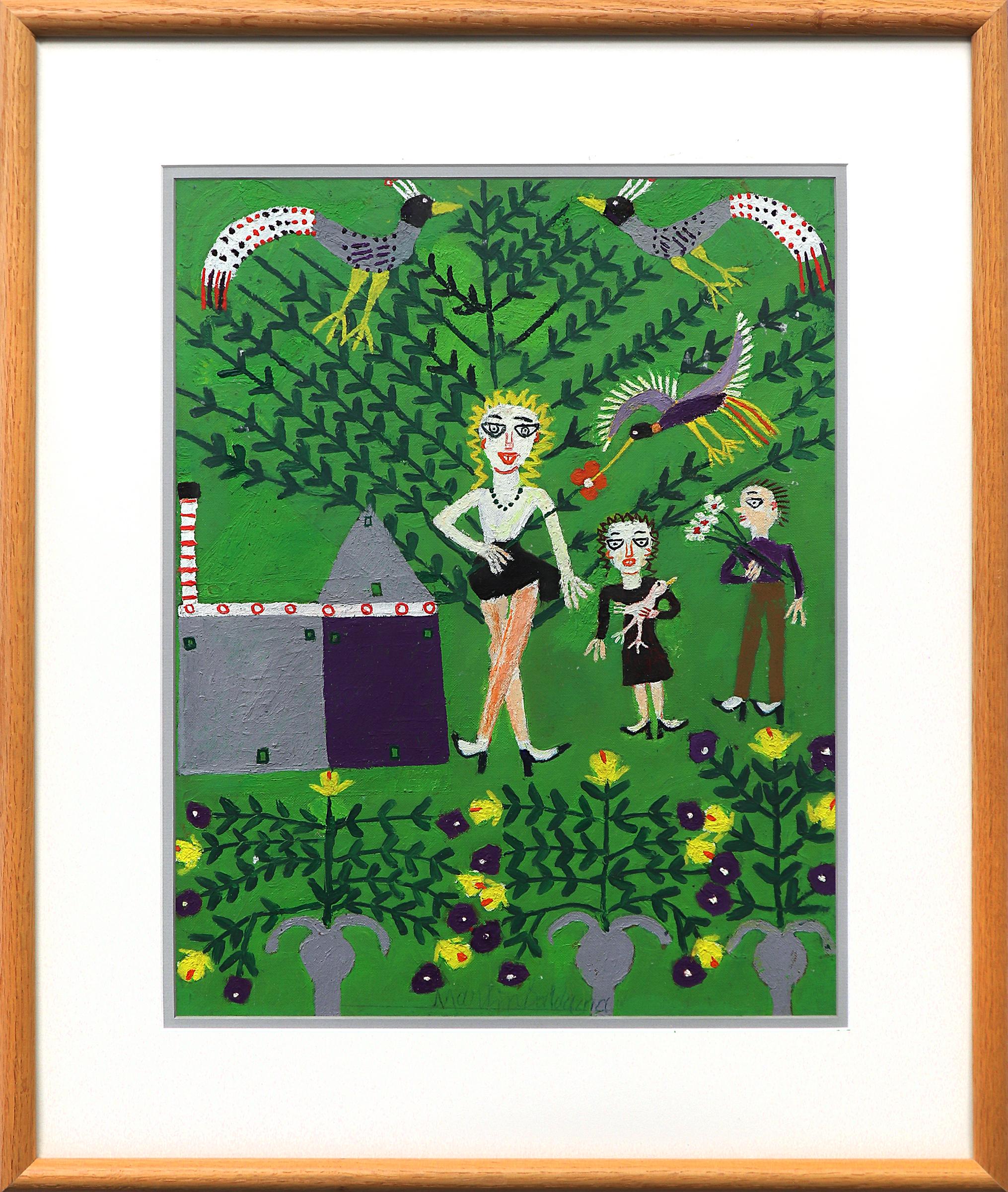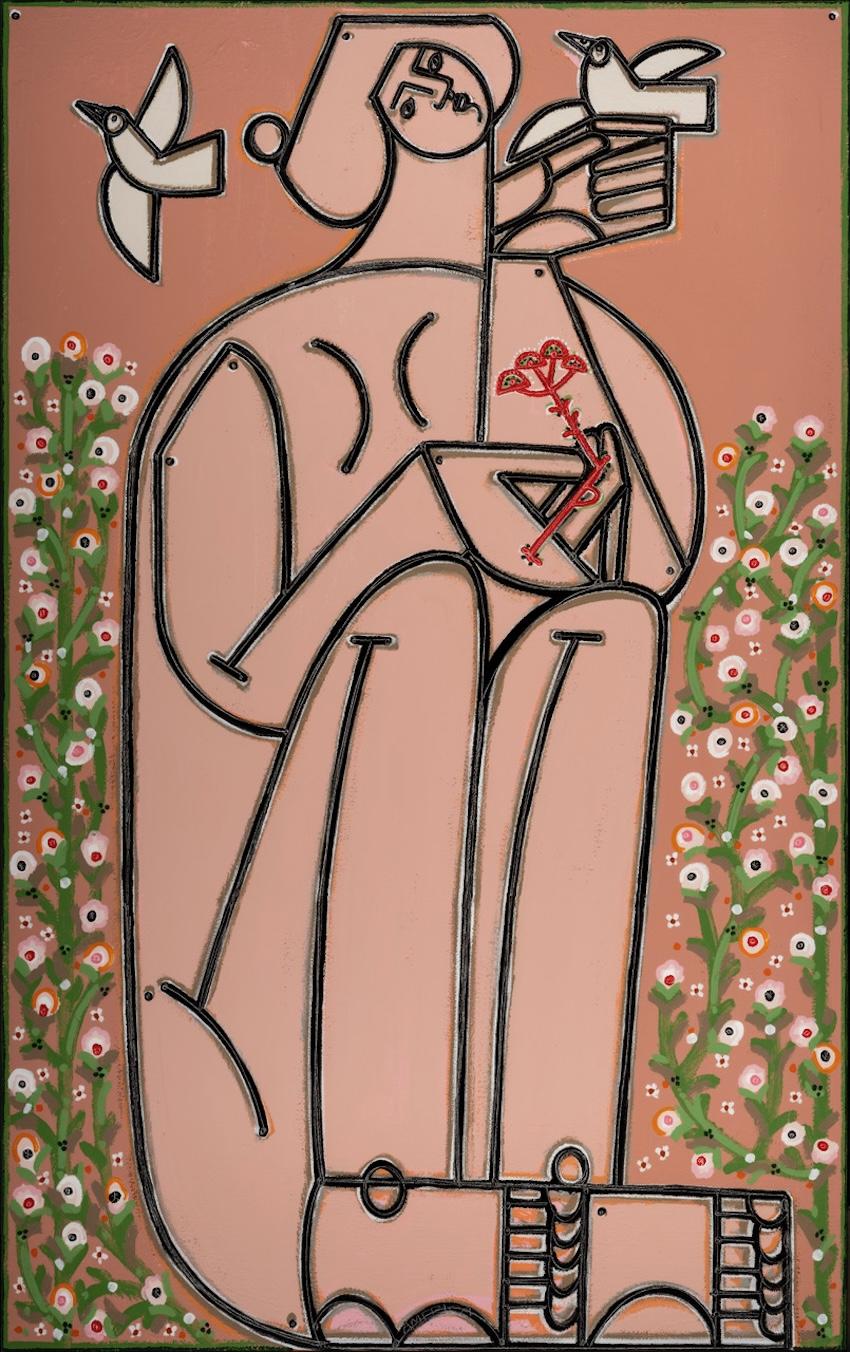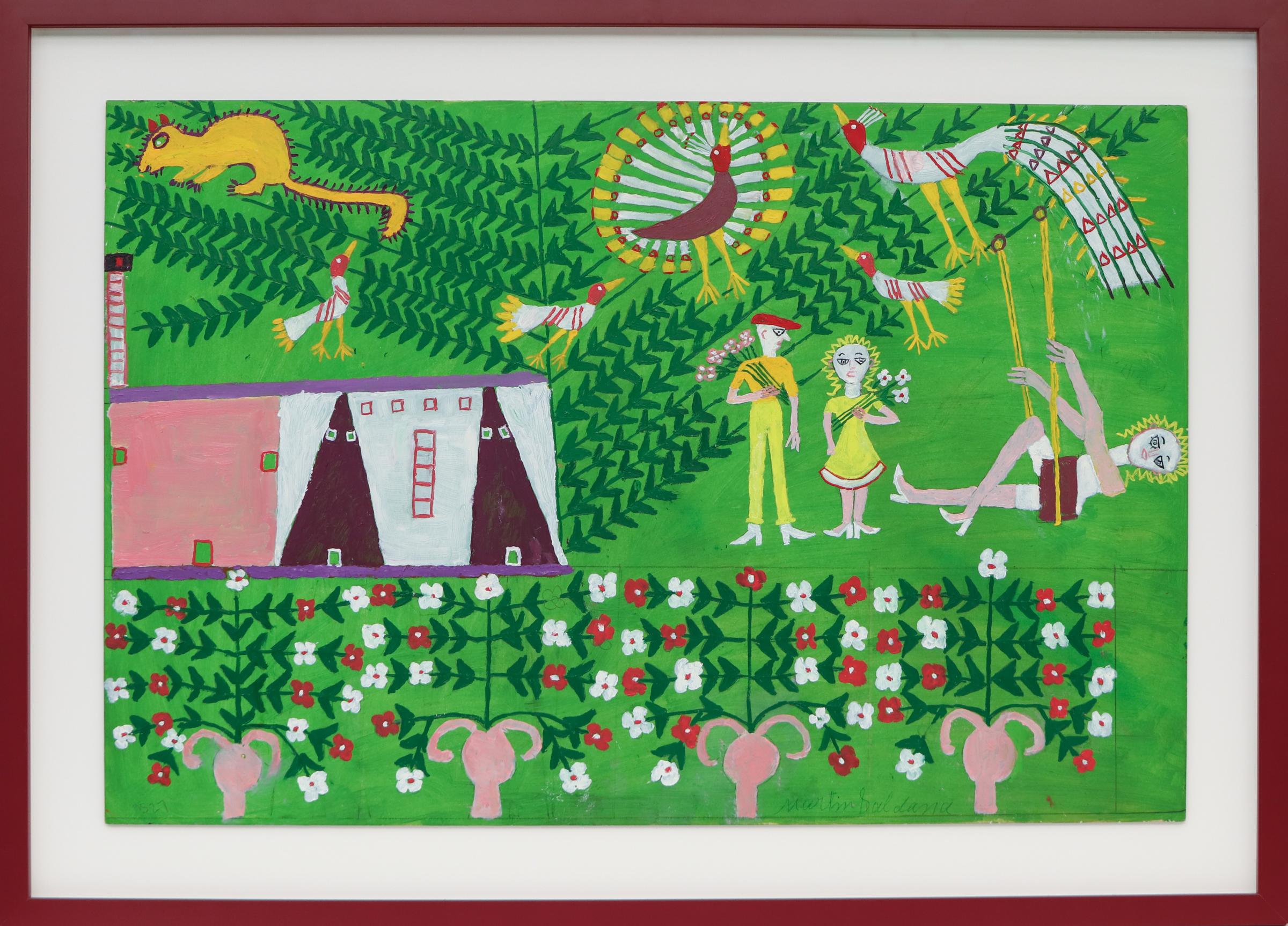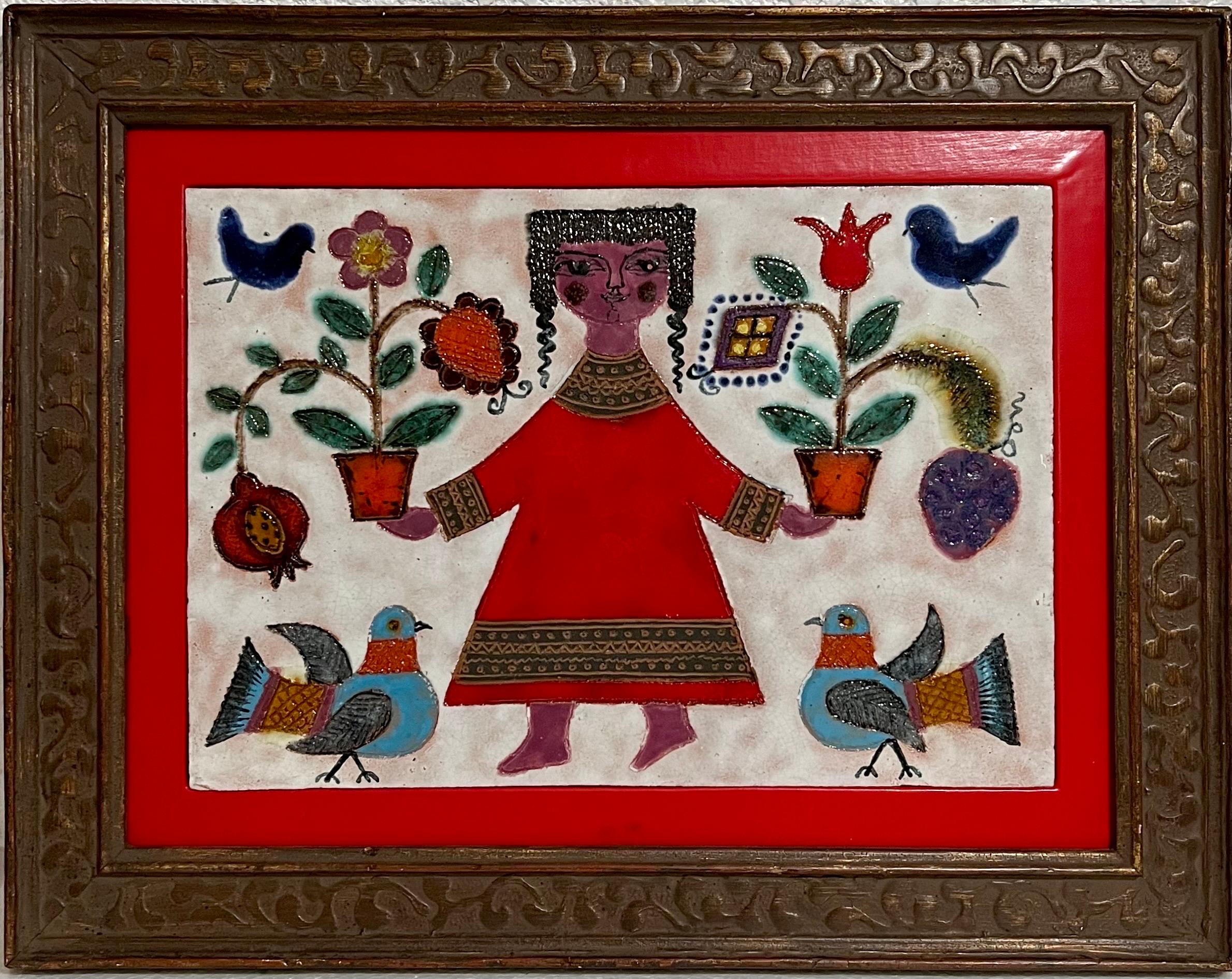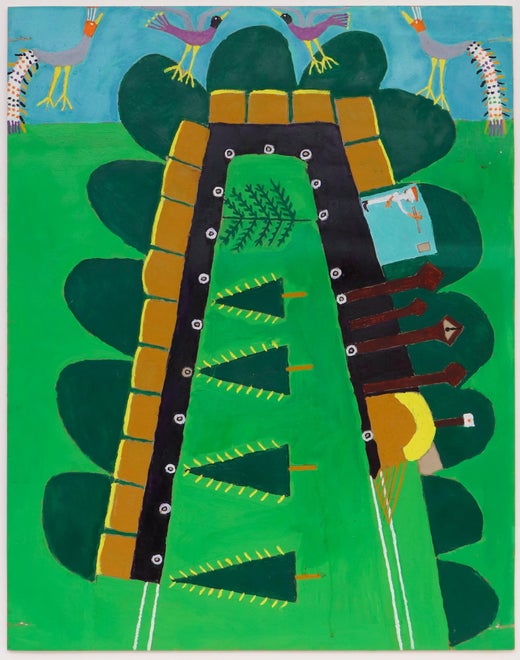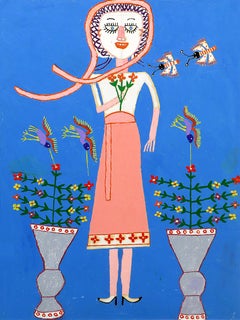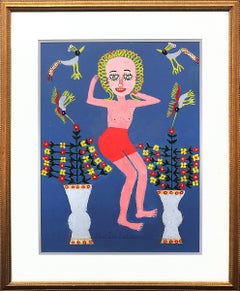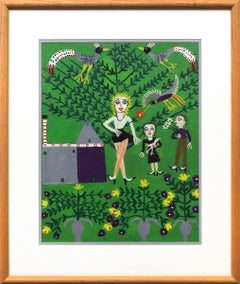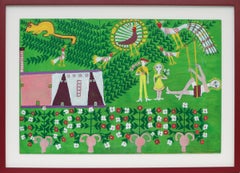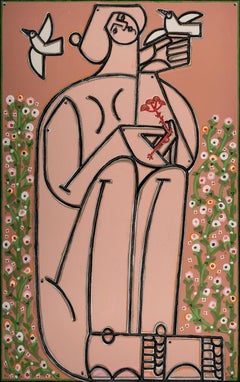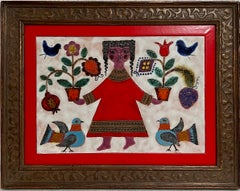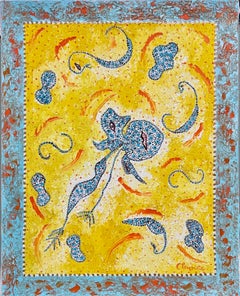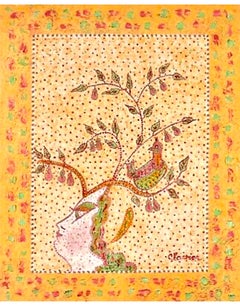Items Similar to Lovely Gal, 1950s Semi-Abstract Figurative Folk Art Oil Painting, & Birds
Video Loading
Want more images or videos?
Request additional images or videos from the seller
1 of 21
Martin SaldanaLovely Gal, 1950s Semi-Abstract Figurative Folk Art Oil Painting, & Birdscirca 1960
circa 1960
$3,250
£2,471.48
€2,850.73
CA$4,552.66
A$5,095.32
CHF 2,660.55
MX$62,163.21
NOK 33,772.23
SEK 32,047.76
DKK 21,287.94
Shipping
Retrieving quote...The 1stDibs Promise:
Authenticity Guarantee,
Money-Back Guarantee,
24-Hour Cancellation
About the Item
"Lovely Gal" is a charming oil on board painting by Martin Saldaña (1874-1965), a self-taught outsider artist known for his vibrant, whimsical depictions of childhood memories and rural life. This semi-abstract figurative work features a colorful palette of bold hues, with flowers and birds that reflect Saldaña's deep connection to nature and his Mexican heritage. The painting is presented in a custom frame with outer dimensions of 30 ¾ x 25 ⅜ x 1 ⅝ inches, and the image size is 24 ½ x 19 ⅛ inches.
About the Artist:
Martin Saldaña was born in 1874 at Rancho Neuvo, Mexico, and led a modest life, working as a cook at Denver's iconic Brown Palace Hotel. At the age of 76, Saldaña began attending children’s art classes at the Denver Art Museum, sparking a late-blooming artistic career. Over the next 15 years, he vividly captured memories of his childhood in San Luis Potosi, Mexico, focusing on ranch life, landscapes, and his love for animals.
Saldaña's work is noted for its bold, geometric figures and vibrant colors, often evoking the influence of Mexican tapestries. His paintings are considered to be naïve and folk art, characterized by their simple, direct, and highly personal style. Saldaña's prolific output—creating a new painting nearly every three days—resulted in an impressive collection of artworks that continue to be celebrated today.
Saldaña’s endearing style continues to captivate art enthusiasts, offering a glimpse into a rich, nostalgic world filled with vibrant colors and heartfelt simplicity.
©David Cook Galleries, LLC
- Creator:Martin Saldana (1874 - 1965, Mexican)
- Creation Year:circa 1960
- Dimensions:Height: 30.75 in (78.11 cm)Width: 25.5 in (64.77 cm)Depth: 1.5 in (3.81 cm)
- Medium:
- Movement & Style:
- Period:
- Framing:Frame IncludedFraming Options Available
- Condition:Very good vintage condition, detailed condition report is available upon request.
- Gallery Location:Denver, CO
- Reference Number:Seller: 261301stDibs: LU27310219632
Martin Saldana
Born in 1874, Saldaña grew up at Rancho Neuvo in Mexico. In 1950, at the age of 76, he began attending children's art classes at the Denver Art Museum. For the next fitfteen years, Saldaña Imaginatively documented whimsical memories from his childhood in San Luis Potosi, Mexico, portraying ranch life, landscapes, and his great love of animals. The prolific artist painted every day, completing a new piece about every three days and amassing an impressive body of work for the former cook at the Denver landmark, the Brown Palace Hotel. Saldaña’s vibrant palette and geometric figures are reminiscent of the tapestries of his Mexican heritage and the paintings, primarily in oil, are innocent and endearing. Saldaña is considered to be a outsider artist, a folk artist who is self-taught, whose work is simple, direct, and high personal. Works Held: Denver Art Museum, University of Wyoming Art Museum, The Colorado Springs Fine Art Center, International Folk Art Museum, Neuss In Aberthor Museum, Stedelijk Museum ©David Cook Galleries, LLC
About the Seller
5.0
Gold Seller
Premium sellers maintaining a 4.3+ rating and 24-hour response times
Established in 1979
1stDibs seller since 2013
291 sales on 1stDibs
Typical response time: 13 hours
- ShippingRetrieving quote...Shipping from: Denver, CO
- Return Policy
Authenticity Guarantee
In the unlikely event there’s an issue with an item’s authenticity, contact us within 1 year for a full refund. DetailsMoney-Back Guarantee
If your item is not as described, is damaged in transit, or does not arrive, contact us within 7 days for a full refund. Details24-Hour Cancellation
You have a 24-hour grace period in which to reconsider your purchase, with no questions asked.Vetted Professional Sellers
Our world-class sellers must adhere to strict standards for service and quality, maintaining the integrity of our listings.Price-Match Guarantee
If you find that a seller listed the same item for a lower price elsewhere, we’ll match it.Trusted Global Delivery
Our best-in-class carrier network provides specialized shipping options worldwide, including custom delivery.More From This Seller
View AllOriginal Naïve Folk Art Oil Painting by Martin Saldaña – Whimsical Girl, Flowers
By Martin Saldana
Located in Denver, CO
This enchanting original oil painting, Pinky, is a beautiful example of whimsical Naïve folk art by the artist Martin Saldaña. The artwork features a charming portrait of a young gir...
Category
1950s Folk Art Figurative Paintings
Materials
Oil
Small Nude 20th Century Brightly Colored Figurative Oil Painting Folk Art
By Martin Saldana
Located in Denver, CO
This vibrant, semi-abstract oil painting titled Small Nude is a striking example of Martin Saldaña's unique artistic style. Signed by the artist, this mid-century piece features a pl...
Category
Mid-20th Century Folk Art Figurative Paintings
Materials
Oil
Seated Girl and Hummingbird, Vibrant Figurative Oil Folk Art Painting in Green
By Martin Saldana
Located in Denver, CO
"Seated Girl and Hummingbird" is a vibrant oil on board painting by Mexican artist Martin Saldaña (1874-1965). This captivating folk art piece portrays three figures standing near a ...
Category
Early 20th Century Folk Art Figurative Paintings
Materials
Oil
1960s Mexican-American Folk Art Oil Painting, Girl on Swing, Birds, Bright Color
By Martin Saldana
Located in Denver, CO
This vibrant 1950s-1960s oil painting by renowned Mexican-American folk artist Martin Saldaña (1874–1965) depicts a whimsical outdoor scene with a young girl on a swing, accompanied ...
Category
Mid-20th Century Folk Art Landscape Paintings
Materials
Oil
1960s Mexican-American Folk Art Oil Painting – Colorful Rural Farm Scene
By Martin Saldana
Located in Denver, CO
“Ethel, The Blue Spotted Cow” is a bold and joyful original folk art oil painting by Mexican-American artist Martin Saldaña. Bursting with color and charm, this large-scale work feat...
Category
20th Century Folk Art Landscape Paintings
Materials
Oil
Mexican American Folk Art Oil Painting – Figures, Houses & Landscape, 20th C.
By Martin Saldana
Located in Denver, CO
A charming and colorful oil on board painting by acclaimed Mexican American folk artist Martin Saldaña (1874–1965), titled “Farm and Figures.” This unique 20th-century outsider artwo...
Category
Mid-20th Century Folk Art Figurative Paintings
Materials
Oil
You May Also Like
Bird and Female Figure, Woman with Doves by America Martin
By America Martin
Located in 326 N Coast Hwy. | Laguna Beach, CA
America Martin
"Woman with Doves"
Oil & Acrylic on Canvas
85 x 53.25 inches
86.5 x 54.5 framed
Exploring the identity of both her namesake and country, LA-based America Martin draws...
Category
2010s Contemporary Figurative Paintings
Materials
Canvas, Oil, Acrylic
$22,120 Sale Price
20% Off
Girl & Plants Enamel Glazed Ceramic Plaque Israeli Artist Awret Naive Folk Art
By Irene Awret
Located in Surfside, FL
This is a rare ceramic plaque painted with enamel glaze by famed Israeli German artist Irene Awret (these are generally hand signed Awret Safed on the verso. I just have not opened the frame to check) the actual glazed ceramic is 10.25 X 14.75 inches.
It depicts a girl or woman with potted plants, birds, pomegranates and other fruits and flowers in a naif, folk art style.
Irène Awret was born to a Jewish family in Berlin called Spicker, the youngest of three children. Her mother died in 1927, when Irène was six years old. In 1937 she was forced to stop high school, due to the Nazi race laws. Because she could not continue her regular studies, her father sent her to study drawing, painting and art restoration with a Jewish painter. Among his students were a large number of German Jews who knew they would have to leave Germany within a short time and would require a profession to enable them to support themselves.
When the situation grew worse, following the Kristallnacht (the first major attack on German and Austrian Jews in November 1938), her uncle decided to move to Belgium. In 1939 the situation became even worse - her father was fired from his job and the family were forced to leave their home. As a result, Awret's father tried to send her and her sister to Belgium, with the help of smugglers. The first smuggler proved to be a double agent and they were sent back from Aachen to Berlin. Two weeks later they made a second, successful, attempt to sneak across the border.
Awret worked for a Dutch Jewish family as a maid. As she had her room and board there, she was able to save enough money to study art part-time at Brussels' Académie Royal des Beaux-Arts. A few months later Awret's father joined her and her financial situation became easier. She left her job and studied full-time, helping support herself with restoration work when it was available and by painting portraits to order.
Later, Awret found a hiding place on a farm in Waterloo with a Jewish family who were connected with the underground. In January 1943 she had to return to Brussels, living with a false identity card which stated she was a married woman with two children. Awret succeeded in renting an attic without informing the police where she was - she told her landlady that she had been forced to flee her husband because he beat her. While there, she supported herself by restoring wooden sculptures.
A Jewish informer gave her up to the Gestapo, accompanying the two Gestapo men who arrested her. Awret was able to take a bag containing food and drawing materials. She was detained in the Gestapo cellars in Brussels where she drew. Because there was nothing there to draw, she sketched her own hand (view this work). Awret was interrogated in order to reveal the hiding place of her father who was still in Brussels. The National Socialist regime was determined to persecute him, even though he had fought for Germany in World War I and been permanently disabled. They stepped up their torture and brought Awret before Hartmann, the head of the Gestapo in Brussels. When Hartmann saw her block of drawings, he asked her where she had studied art and halted the interrogation.
Awret was placed in a narrow cell and then transferred to Malines camp, which the Belgian's called Mechelen. Malines was a transit camp to Auschwitz, regularly sending 2000 people at a time. Although she arrived just before Transport No. 20, Irène Awret avoided being included. Instead she was put to work in the leather workshop, decorating broaches. While she was there, Hartmann visited the camp and spotted her: "I could have discovered where your father is hiding," he told her. When her artistic talents became known, she was transferred to the Mahlerstube (artist's workshop) where she worked producing graphics for the Germans until the end of the war. When Carol (Karel) Deutsch (whose works are now on view at Yad Vashem) was sent from Mechelen to his death with his wife, he left young Irene his paintbox. Irene also recalls seeing the great painter Felix Nussbaum and his wife being pushed into a boxcar bound for the gas, and tells of the aftermath of the famous 20th Train incident, when a young Jewish doctor armed only with a pistol and helped by two unarmed friends with a lantern ambushed one of Mechelen's Auschwitz-bound trains carrying 1,618 Jews, most of whom had fled Eastern Europe for Belgium.
Awret's job enabled her to paint and draw - mainly in pencil, but also in watercolors and oils. In the artists' workshop she met a Jewish refugee from Poland - Azriel Awret - who would later become her husband. Among the other artists in the workshop were Herbert von Ledermann-Vütemberg, a sculptor from an aristocratic family with Jewish roots, Léon Landau, and Smilowitz, who perished in the camps in the East. Irène and Azriel tried to bribe a German officer to prevent Smilowitz's deportation. Not only were they unsuccessful, but they were almost put onto the same train. Jacques Ochs was another artist with whom they became friends in the camp. Ochs, a French-born Protestant who lived in Belgium, was interned as a political prisoner. He remained in Belgium after liberation.
After the war the Awrets immigrated to Israel and made their home in Safed. They continued to work, and were instrumental in founding Safed's artists' quarter.
The Beit Lohamei Haghetaot (Ghetto Fighters' House Museum) art collection holds works donated by Awret. These date from her time in Malines camp and from her stay in Brussels after the war, when she was in the company of orphans who had hidden while their parents were sent to Auschwitz. Her highly expressive works have made their way to exhibitions at theTel Aviv Museum, the Haifa Museum of Modern Art and the Modern Art Gallery in Washington, D.C., as well as into the private collections of such individuals as Dr. Jonas Salk...
Category
1950s Expressionist Figurative Paintings
Materials
Enamel
Whimsical French Folk Art, Naive, Oil Painting Madeline Marie Christine Clavier
By Madeline Christine Clavier
Located in Surfside, FL
MADELINE CHRISTINE CLAVIER (1913-2015)
Signature: Signed lower right & titled verso
Medium: Oil on canvas
Provenance: The collection of the artist's family
Marie Christine Clavier was born in Saigon, Vietnam in 1913 to French parents and lived there for her formative years. She returned to France as a teenager and began to study painting. Her work quickly developed into whimsical paintings of poetry and songs – harmonized in a unique and distinct painting technique. Her work has an impasto feel and a folk art, outsider artist sensibility to it. Similar in style to Maik and other fantasy realists who use animals, flowers and foliage in their artworks. Marie Clavier painted ro herself rather than for profit as she was quite independently wealthy. Her work is in a more whimsical style of Francoise Gilot. She exhibited extensively in the United States in the 1970s especially across Connecticut and New York, showing at various galleries and cultural centres. She had numerous solo exhibitions in the 1970’s- notably at the Maison Francaise in New York and New York University. She showed at Galerie Bernheim Jeune in Paris. She won many awards for her work including Gold Medals and Palme D’Or medals. In 1988 the prestigious art publisher Leopard D’Or produced catalogue book on her life and work – by this point she had virtually given up painting. She died in 2015 aged 102.
Bernheim-Jeune gallery is one of the oldest art galleries in Paris. Opened on Rue Laffitte in 1863 by Alexandre Bernheim (1839-1915), friend of Delacroix, Corot and Courbet, it changed location a few times before settling on Avenue Matignon. The gallery promoted realists, Barbizon school paintings and, in 1874, the first impressionist and later post-impressionist painters. It closed in 2019. In 1901, Alexandre Bernheim, with his sons, Josse (1870-1941), and Gaston (1870-1953), organized the first important exhibition of Vincent van Gogh paintings in Paris with the help of art critic Julien Leclercq. In 1906, Bernheim-Jeune frères started presenting works by Pierre Bonnard, Edouard Vuillard, Paul Cezanne, Henri-Edmond Cross, Kees van Dongen, Henri Matisse, Le Douanier Rousseau, Raoul Dufy, Maurice de Vlaminck, Amedeo Modigliani, Maurice Utrillo and Georges Dufrenoy. From 1906 to 1925, art critic Félix Fénéon was the director of the gallery and was instrumental in bringing in the art of Georges Seurat and Umberto Boccioni.
In 1922, an exhibition brought together works by Alice Halicka, Auguste Herbin, Pierre Hodé, Moise Kisling, Marie Laurencin, Henri Lebasque, Fernand Leger and Henri Matisse. The gallery now exhibits painters and sculptors in the tradition of the École de Paris and artists such as Jean Carzou, Shelomo Selinger or Pollès.
Her style is a recognizable, cheerful, whimsical and a happy creation. Naïve art is any form of visual art that is created by a person who lacks the formal education and training that a professional artist undergoes (in anatomy, art history, technique, perspective, ways of seeing). Unlike folk art, naïve art does not necessarily evince a distinct cultural context or tradition. Naïve art is recognized, and often imitated, for its childlike simplicity and frankness. Paintings of this kind typically have a flat rendering style with a rudimentary expression of perspective.
One particularly influential painter of "naïve art" was Henri Rousseau (1844–1910), a French Post-Impressionist who was discovered by Pablo Picasso. Naïve art is often seen as outsider art that is by someone without formal (or little) training or degree. While this was true before the twentieth century, there are now academies for naïve art. Naïve art is now a fully recognized art genre, represented in art galleries worldwide. Museums devoted to naïve art now exist in Kecskemét, Hungary; Riga, Latvia; Jaen, Spain; Rio de Janeiro, Brasil; Vicq France and Paris. Another term related to (but not completely synonymous with) naïve art is folk art. There also exist the terms "naïvism" and "primitivism" which are usually applied to professional painters working in the style of naïve art (like Paul Gauguin, Mikhail Larionov, Paul Klee). At all events, naive art can be regarded as having occupied an "official" position in the annals of twentieth-century art since - at the very latest - the publication of the Der Blaue Reiter, an almanac in 1912. Wassily Kandinsky and Franz Marc, who brought out the almanac, presented 6 reproductions of paintings by le Douanier' Rousseau (Henri Rousseau), comparing them with other pictorial examples. However, most experts agree that the year that naive art was "discovered" was 1885, when the painter Paul Signac became aware of the talents of Henri Rousseau and set about organizing exhibitions of his work in a number of prestigious galleries. The Earth Group (Grupa Zemlja) were Croatian artists, architects and intellectuals active in Zagreb from 1929 to 1935. The group included the painters Krsto Hegedušić, Edo Kovačević, Omer Mujadžić, Kamilo Ružička, Ivan Tabaković, and Oton Postružnik, the sculptors Antun Augustinčić, Frano Kršinić, and the architect Drago Ibler. A term applied to Yugoslav (Croatian) naive painters working in or around the village of Hlebine, near the Hungarian border, from about 1930. Some of the best known naive artists are Dragan Gaži, Ivan Generalić, Josip Generalić...
Category
20th Century Folk Art Animal Paintings
Materials
Canvas, Oil
Whimsical French Folk Art, Naive, Oil Painting Madeline Marie Christine Clavier
By Madeline Christine Clavier
Located in Surfside, FL
MADELINE CHRISTINE CLAVIER (1913-2015)
Signature: Signed lower right & titled verso
Medium: Oil on canvas
Provenance: The collection of the artist's family
Marie Christine Clavier was born in Saigon, Vietnam in 1913 to French parents and lived there for her formative years. She returned to France as a teenager and began to study painting. Her work quickly developed into whimsical paintings of poetry and songs – harmonized in a unique and distinct painting technique. Her work has an impasto feel and a folk art, outsider artist sensibility to it. Similar in style to Maik and other fantasy realists who use animals, flowers and foliage in their artworks. Marie Clavier painted ro herself rather than for profit as she was quite independently wealthy. She exhibited extensively in the United States in the 1970s especially across Connecticut and New York, showing at various galleries and cultural centres. She had numerous solo exhibitions in the 1970’s- notably at the Maison Francaise in New York and New York University. She showed at Galerie Bernheim Jeune in Paris. She won many awards for her work including Gold Medals and Palme D’Or medals. In 1988 the prestigious art publisher Leopard D’Or produced catalogue book on her life and work – by this point she had virtually given up painting. She died in 2015 aged 102.
Bernheim-Jeune gallery is one of the oldest art galleries in Paris. Opened on Rue Laffitte in 1863 by Alexandre Bernheim (1839-1915), friend of Delacroix, Corot and Courbet, it changed location a few times before settling on Avenue Matignon. The gallery promoted realists, Barbizon school paintings and, in 1874, the first impressionist and later post-impressionist painters. It closed in 2019. In 1901, Alexandre Bernheim, with his sons, Josse (1870-1941), and Gaston (1870-1953), organized the first important exhibition of Vincent van Gogh paintings in Paris with the help of art critic Julien Leclercq. In 1906, Bernheim-Jeune frères started presenting works by Pierre Bonnard, Edouard Vuillard, Paul Cezanne, Henri-Edmond Cross, Kees van Dongen, Henri Matisse, Le Douanier Rousseau, Raoul Dufy, Maurice de Vlaminck, Amedeo Modigliani, Maurice Utrillo and Georges Dufrenoy. From 1906 to 1925, art critic Félix Fénéon was the director of the gallery and was instrumental in bringing in the art of Georges Seurat and Umberto Boccioni.
In 1922, an exhibition brought together works by Alice Halicka, Auguste Herbin, Pierre Hodé...
Category
20th Century Folk Art Animal Paintings
Materials
Canvas, Oil
Contemporary English Painting 'Woman with Birds' by Cornelia O’Donovan
Located in Gloucestershire, GB
Large and beautiful contemporary painting by Cornelia O’Donovan (RCA, MA) 'Woman with Birds'.
Signed version 'Cornelia O Donovan', 2023.
Cornelia’s art is shown in several galleries ...
Category
21st Century and Contemporary British Modern Paintings
Materials
Canvas, Paint
Surreal Blue Bird Lady Abstract Painting 1980
Located in Douglas Manor, NY
3715 Acrylic on board
Set in a faux vintage bamboo wood frame
Category
1980s Abstract Paintings
Materials
Acrylic
More Ways To Browse
76 Oil Painting
Colorful Folk Art Painting
Mexican Folk Art Painting
Mexican Tapestry
David Cook Gallery
San Luis Potosi
Grand Palais
Cartoon Pop Art
Oil Portrait Spanish
Boy In Oil Painting
Oil Painting Of Two Women
American Portrait Early 20th Century
19th Century Genre Painting
Mexican Street Art
Page Oil Painting
Mother With Children Painting
Modern Nude Oil Paintings
Blue African Painting
